Stress Monitoring Using Wearable Sensors: A Pilot Study and Stress-Predict Dataset
Abstract
:1. Introduction
1.1. Related Work
1.2. Study Objectives
- Collect physiological data for wearable stress monitoring (stress-predict dataset).
- Perform statistical analysis and analyse the dataset to study association of various physiological variables and stress levels.
- Assess the effectiveness of stress-inducing activities for experimental studies.
1.3. Key Contributions
- Collected PPG signals using an Empatica E4 watch (a wrist-worn device) and developed an open-access dataset.
- Estimated respiratory rate readings from the raw signal using a novel PPG-based respiratory rate estimation algorithm [24] and included them in the dataset.
- Performed individual-level statistical analysis using a novel method based on the Bayesian framework and time-efficient approximate Expectation-Maximisation (EM) algorithm [25].
2. Material and Methods
2.1. Study Design
2.2. Selection and Recruitment of Participants
2.3. Study Methodology and Protocol
2.4. Study Sample Size Calculation
2.5. Data Acquisition
Empatica E4 Photoplethysmogram (PPG) Sensor
2.6. Data Analysis Matrices
- (i)
- Linear Mixed Model analysis
- (ii)
- Adaptive reference range analysis
3. Data Features Included in Stress-Predict Dataset
3.1. Blood Volume Pulse
- The diastolic point is the local minima point, used to calculate the inter-beat-interval.
- The systolic point is a local maxima point, used to calculate the vasoconstriction of the participant.
- The presence of a dicrotic notch is observed in the study of different types of cardiac diseases.
- The dicrotic wave is the effect of the dicrotic notch and is referred to as the second wave.
3.2. Inter-Beat-Intervals
3.3. Heart Rate
3.4. Labels
3.5. Estimation of Respiratory Rate Data
4. Analysis and Results
4.1. Population-Based Analysis Using Linear Mixed Model
4.2. Individual Participant’s Analysis Using Adaptive Reference Range
5. Discussion and Conclusions
Supplementary Materials
Author Contributions
Funding
Institutional Review Board Statement
Informed Consent Statement
Data Availability Statement
Conflicts of Interest
References
- Executive, H.S. Work-Related Ill Health and Occupational Disease in Great Britain. 2021. Available online: https://www.hse.gov.uk/statistics/causdis/ (accessed on 20 July 2022).
- Epel, E.S.; Crosswell, A.D.; Mayer, S.E.; Prather, A.A.; Slavich, G.M.; Puterman, E.; Mendes, W.B. More than a feeling: A unified view of stress measurement for population science. Front. Neuroendocrinol. 2018, 49, 146–169. [Google Scholar] [CrossRef]
- Arza, A.; Garzón-Rey, J.M.; Lázaro, J.; Gil, E.; Lopez-Anton, R.; de la Camara, C.; Laguna, P.; Bailon, R.; Aguiló, J. Measuring acute stress response through physiological signals: Towards a quantitative assessment of stress. Med. Biol. Eng. Comput. 2019, 57, 271–287. [Google Scholar] [CrossRef] [PubMed] [Green Version]
- Tawakol, A.; Ishai, A.; Takx, R.A.; Figueroa, A.L.; Ali, A.; Kaiser, Y.; Truong, Q.A.; Solomon, C.J.; Calcagno, C.; Mani, V.; et al. Relation between resting amygdalar activity and cardiovascular events: A longitudinal and cohort study. Lancet 2017, 389, 834–845. [Google Scholar] [CrossRef] [Green Version]
- Reis, R.S.; Hino, A.A.; Añez, C.R. Perceived stress scale. J. Health Psychol. 2010, 15, 107–114. [Google Scholar] [CrossRef] [PubMed] [Green Version]
- Mozos, O.M.; Sandulescu, V.; Andrews, S.; Ellis, D.; Bellotto, N.; Dobrescu, R.; Ferrandez, J.M. Stress Detection Using Wearable Physiological and Sociometric Sensors. Int. J. Neural Syst. 2017, 27, 1650041. [Google Scholar] [CrossRef] [PubMed] [Green Version]
- Brown, E.G.; Creaven, A.-M.; Gallagher, S. Loneliness and cardiovascular reactivity to acute stress in younger adults. Int. J. Psychophysiol. 2019, 135, 121–125. [Google Scholar] [CrossRef]
- al’Absi, M.; Hatsukami, D.; Davis, G.L.; Wittmers, L.E. Prospective examination of effects of smoking abstinence on cortisol and withdrawal symptoms as predictors of early smoking relapse. Drug Alcohol Depend. 2004, 73, 267–278. [Google Scholar] [CrossRef]
- Hórarinsdóttir, H.T.; Faurholt-Jepsen, M.; Ullum, H.; Frost, M.; Bardram, J.E.; Kessing, L.V. The validity of daily self-assessed perceived stress measured using smartphones in healthy individuals: Cohort study. JMIR Mhealth Uhealth 2019, 7, e13418. [Google Scholar] [CrossRef] [PubMed]
- Kim, S.; Rhee, W.; Choi, D.; Jang, Y.J.; Yoon, Y. Characterizing driver stress using physiological and operational data from real-world electric vehicle driving experiment. Int. J. Automot. Technol. 2018, 19, 895–906. [Google Scholar] [CrossRef]
- Choi, J.; Ahmed, B.; Gutierrez-Osuna, R. Development and evaluation of an ambulatory stress monitor based on wearable sensors. IEEE Trans. Inf. Technol. Biomed. 2011, 16, 279–286. [Google Scholar] [CrossRef] [PubMed]
- Lamichhane, B.; Großekathöfer, U.; Schiavone, G.; Casale, P. Towards stress detection in real-life scenarios using wearable sensors: Normalization factor to reduce variability in stress physiology. In eHealth 360°; Springer: Berlin/Heidelberg, Germany, 2017; pp. 259–270. [Google Scholar]
- Iqbal, T.; Elahi, A.; Wijns, W.; Shahzad, A. Exploring Unsupervised Machine Learning Classification Methods for Physiological Stress Detection. Front. Med. Technol. 2022, 4, 782756. [Google Scholar] [CrossRef] [PubMed]
- Sardo, F.R.; Rayegani, A.; Nazar, A.M.; Balaghiinaloo, M.; Saberian, M.; Mohsan, S.A.H.; Alsharif, M.H.; Cho, H.S. Recent Progress of Triboelectric Nanogenerators for Biomedical Sensors: From Design to Application. Biosensors 2022, 12, 697. [Google Scholar] [CrossRef]
- Iqbal, T.; Redon-Lurbe, P.; Simpkin, A.J.; Elahi, A.; Ganly, S.; Wijns, W.; Shahzad, A. A Sensitivity Analysis of Biophysiological Responses of Stress for Wearable Sensors in Connected Health. IEEE Access 2021, 9, 93567–93579. [Google Scholar] [CrossRef]
- Schmidt, P.; Duerichen, R.; van Laerhoven, K.; Marberger, C.; Reiss, A. Introducing WESAD, a Multimodal Dataset for Wearable Stress and Affect Detection. In Proceedings of the 20th ACM International Conference on Multimodal Interaction, Boulder, CO, USA, 16–20 October 2018; pp. 400–408. [Google Scholar]
- Koldijk, S.; Sappelli, M.; Verberne, S.; Neerincx, M.A.; Kraaij, W. The swell knowledge work dataset for stress and user modeling research. In Proceedings of the 16th International Conference on Multimodal Interaction, Istanbul, Turkey, 12−16 November 2014; pp. 291–298. [Google Scholar]
- el Haouij, N.; Poggi, J.-M.; Sevestre-Ghalila, S.; Ghozi, R.; Jaïdane, M. AffectiveROAD system and database to assess driver’s attention. In Proceedings of the 33rd Annual ACM Symposium on Applied Computing, Pau, France, 9–13 April 2018; pp. 800–803. [Google Scholar]
- Healey, J.; Picard, R. SmartCar: Detecting driver stress. In Proceedings of the 15th International Conference on Pattern Recognition, Barcelona, Spain, 6 August 2002; pp. 218–221. [Google Scholar]
- Shi, Y.; Nguyen, M.H.; Blitz, P.; French, B.; Fisk, S.; de la Torre, F.; Smailagic, A.; Siewiorek, D.P.; al’Absi, M.; Ertin, E.; et al. Personalized stress detection from physiological measurements. Int. Symp. Qual. Life Technol. 2010, 28–29. Available online: http://www.humansensing.cs.cmu.edu/sites/default/files/8stress_detect.pdf (accessed on 2 October 2022).
- Muaremi, A.; Arnrich, B.; Tröster, G. Towards Measuring Stress with Smartphones and Wearable Devices During Workday and Sleep. Bionanoscience 2013, 3, 172–183. [Google Scholar] [CrossRef] [Green Version]
- Hosseini, S.; Gottumukkala, R.; Katragadda, S.; Bhupatiraju, R.T.; Ashkar, Z.; Borst, C.W.; Cochran, K. A multimodal sensor dataset for continuous stress detection of nurses in a hospital. Sci. Data 2022, 9, 255. [Google Scholar] [CrossRef]
- Iqbal, T.; Elahi, A.; Redon, P.; Vazquez, P.; Wijns, W.; Shahzad, A. A Review of Biophysiological and Biochemical Indicators of Stress for Connected and Preventive Healthcare. Diagnostics 2021, 11, 556. [Google Scholar] [CrossRef] [PubMed]
- Iqbal, T.; Elahi, A.; Ganly, S.; Wijns, W.; Shahzad, A. Photoplethysmography-Based Respiratory Rate Estimation Algorithm for Health Monitoring Applications. J. Med. Biol. Eng. 2022, 42, 242–252. [Google Scholar] [CrossRef] [PubMed]
- Roshan, D.; Ferguson, J.; Pedlar, C.R.; Simpkin, A.; Wyns, W.; Sullivan, F.; Newell, J. A comparison of methods to gen-erate adaptive reference ranges in longitudinal monitoring. PLoS ONE 2021, 16, e0247338. [Google Scholar] [CrossRef]
- O’Súilleabháin, P.S.; Hughes, B.M.; Oommen, A.M.; Joshi, L.; Cunningham, S. Vulnerability to stress: Personality facet of vulnerability is associated with cardiovascular adaptation to recurring stress. Int. J. Psychophysiol. 2019, 144, 34–39. [Google Scholar] [CrossRef] [PubMed]
- Allen, A.P.; Kennedy, P.J.; Cryan, J.F.; Dinan, T.G.; Clarke, G. Biological and psychological markers of stress in humans: Focus on the Trier Social Stress Test. Neurosci. Biobehav. Rev. 2014, 38, 94–124. [Google Scholar] [PubMed]
- Scarpina, F.; Tagini, S. The stroop color and word test. Front. Psychol. 2017, 8, 557. [Google Scholar] [CrossRef] [PubMed] [Green Version]
- Helminen, E.C.; Morton, M.L.; Wang, Q.; Felver, J.C. Stress reactivity to the trier social stress test in traditional and virtual environments: A meta-analytic comparison. Psychosom. Med. 2021, 83, 200–211. [Google Scholar] [CrossRef] [PubMed]
- Cohen, S.; Kamarck, T.; Mermelstein, R. A global measure of perceived stress. J. Health Soc. Behav. 1983, 24, 385–396. [Google Scholar] [CrossRef]
- Lee, E.-H. Review of the psychometric evidence of the perceived stress scale. Asian Nurs. Res. (Korean Soc. Nurs. Sci.) 2012, 6, 121–127. [Google Scholar] [CrossRef] [PubMed] [Green Version]
- Spielberger, C.D.; Gorsuch, R.; Lushene, R.; Vagg, P.; Jacobs, G. Manual for the Stait-Trait Anxiety Inventory; Consulting Psychologists Press: Palo Alto, CA, USA, 1983. [Google Scholar]
- Wang, Z.; Fu, S. An analysis of pilot’s physiological reactions in different flight phases. In Proceedings of the International Conference on Engineering Psychology and Cognitive Ergonomics, Heraklion, Greece, 9–14 July 2014; pp. 94–103. [Google Scholar]
- Riley, R.D.; Ensor, J.; Snell, K.I.; Harrell, F.E.; Martin, G.P.; Reitsma, J.B.; Moons, K.G.; Collins, G.; van Smeden, M. Calculating the sample size required for developing a clinical prediction model. BMJ 2020, 368, m441. [Google Scholar] [CrossRef] [Green Version]
- E4 Wristband Technical Specifications. 2022. Available online: https://support.empatica.com/hc/en-us/articles/202581999-E4-wristband-technical-specifications (accessed on 28 July 2022).
- Vallès-Català, T.; Pedret, A.; Ribes, D.; Medina, D.; Traveria, M. Effects of stress on performance during highly demanding tasks in student pilots. Int. J. Aerosp. Psychol. 2021, 31, 43–55. [Google Scholar] [CrossRef]
- Chandra, V.; Priyarup, A.; Sethia, D. Comparative Study of Physiological Signals from Empatica E4 Wristband for Stress Classification. In Proceedings of the International Conference on Advances in Computing and Data Sciences, Nashik, India, 23–24 April 2021; pp. 218–229. [Google Scholar]
- Kim, M.; Kim, J.; Park, K.; Kim, H.; Yoon, D. Comparison of Wristband Type Devices to Measure Heart Rate Variability for Mental Stress Assessment. In Proceedings of the 2021 International Conference on Information and Communication Technology Convergence (ICTC), Jeju Island, Korea, 14 August 2021; pp. 766–768. [Google Scholar]
- Giorgi, A.; Ronca, V.; Vozzi, A.; Sciaraffa, N.; di Florio, A.; Tamborra, L.; Simonetti, I.; Aricò, P.; di Flumeri, G.; Rossi, D.; et al. Wearable technologies for mental workload, stress, and emotional state assessment during working-like tasks: A comparison with laboratory technologies. Sensors 2021, 21, 2332. [Google Scholar] [CrossRef]
- Schuurmans, A.A.T.; de Looff, P.; Nijhof, K.S.; Rosada, C.; Scholte, R.H.; Popma, A.; Otten, R. Validity of the Empatica E4 Wristband to Measure Heart Rate Variability (HRV) Parameters: A Comparison to Electrocardiography (ECG). J. Med. Syst. 2020, 44, 1–11. [Google Scholar] [CrossRef]
- E4 Data-BVP Expected Signal. 2020. Available online: https://support.empatica.com/hc/en-us/articles/360029719792-E4-data-BVP-expected-signal (accessed on 28 July 2022).
- E4 Data-IBI Expected Signal. 2020. Available online: https://support.empatica.com/hc/en-us/articles/360030058011-E4-data-IBI-expected-signal (accessed on 28 July 2022).
- E4 Wristband Data. 2022. Available online: https://support.empatica.com/hc/en-us/sections/200582445-E4-wristband-data (accessed on 28 July 2022).


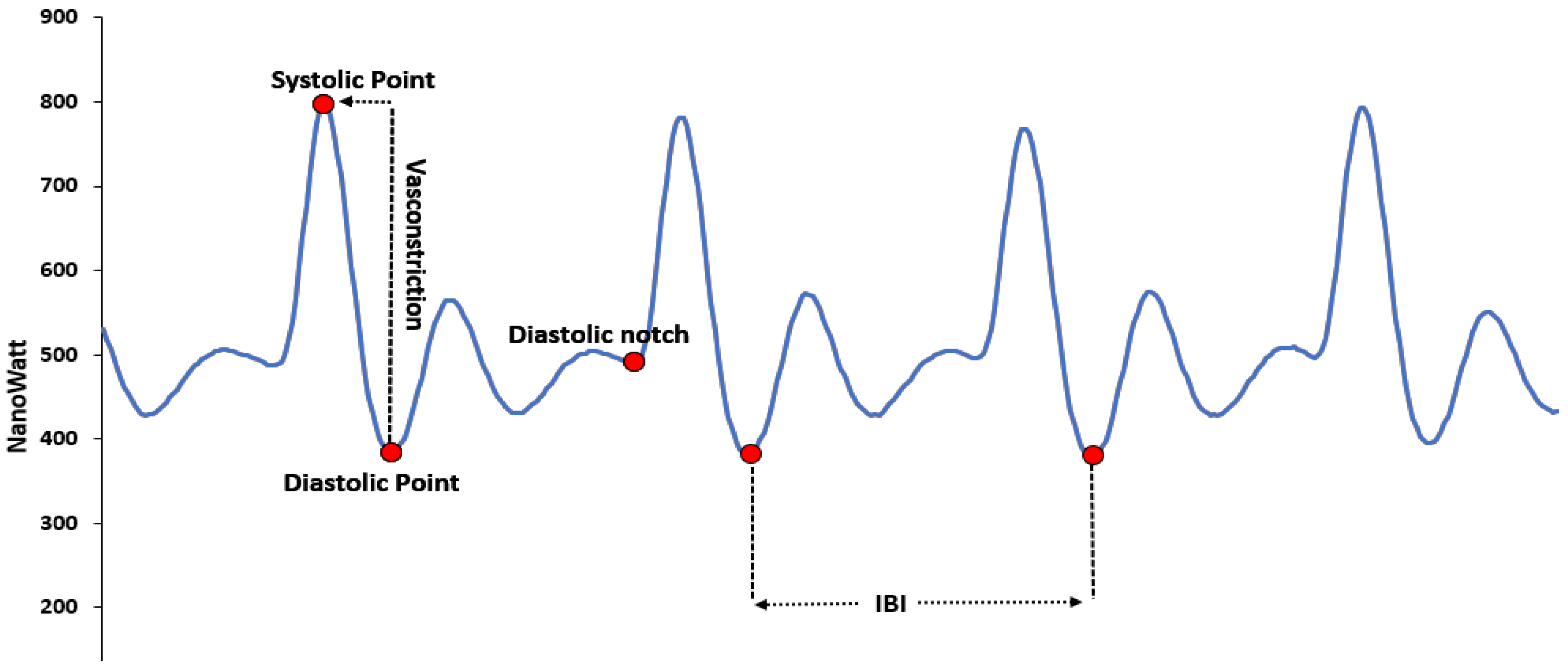
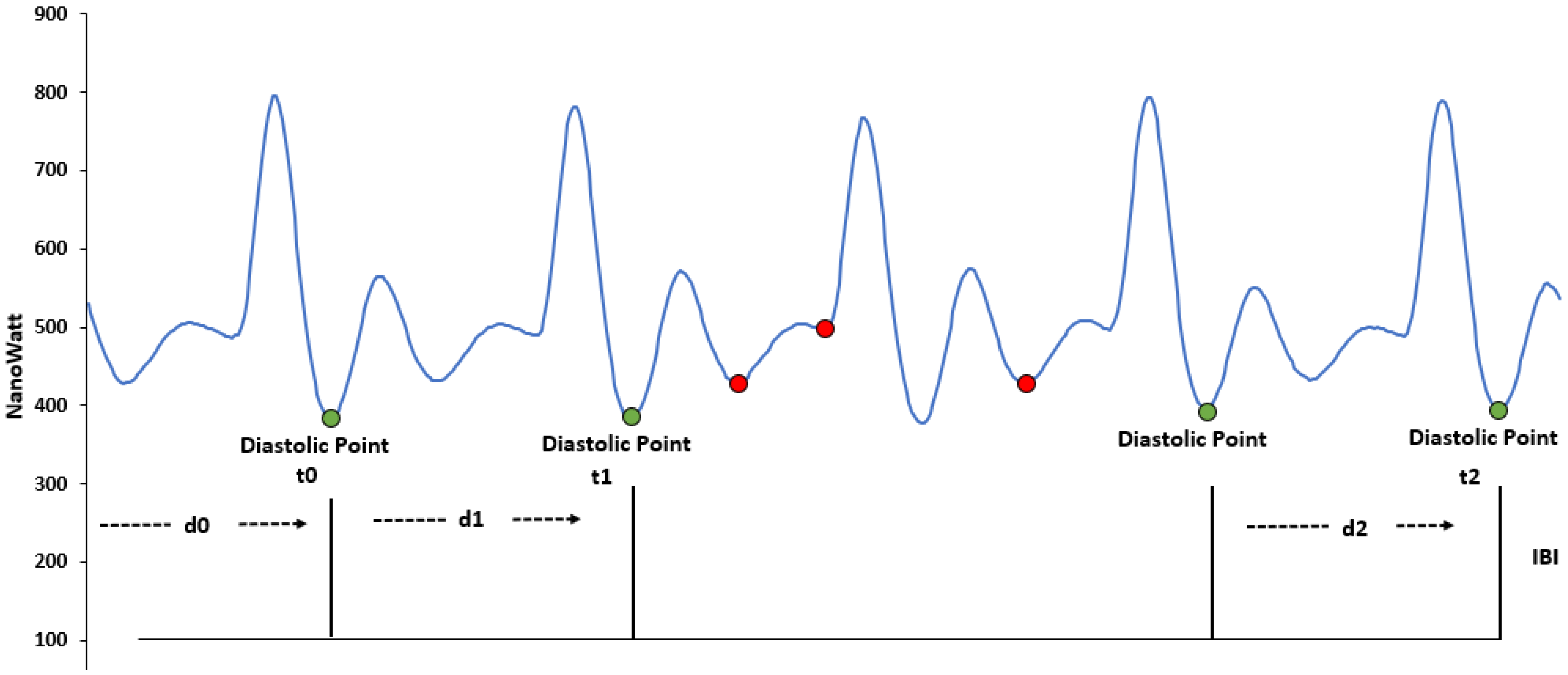
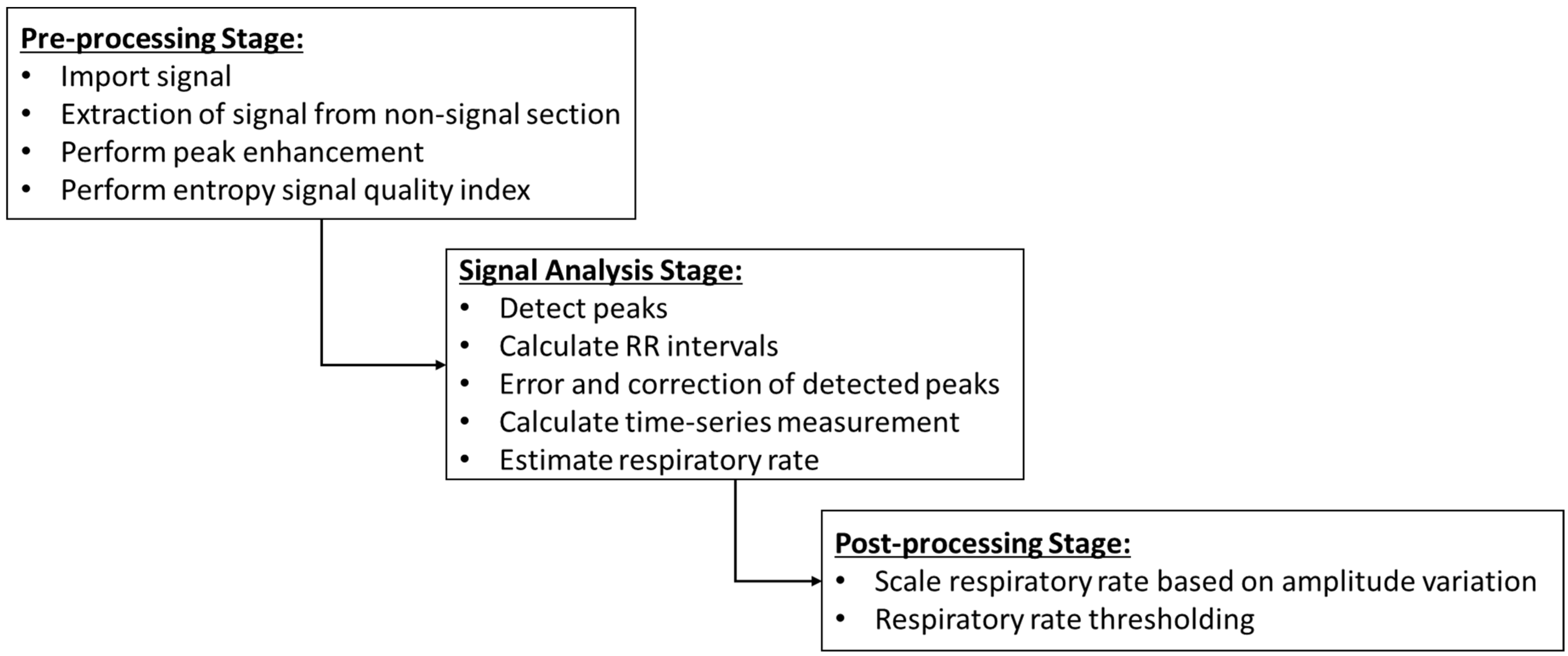
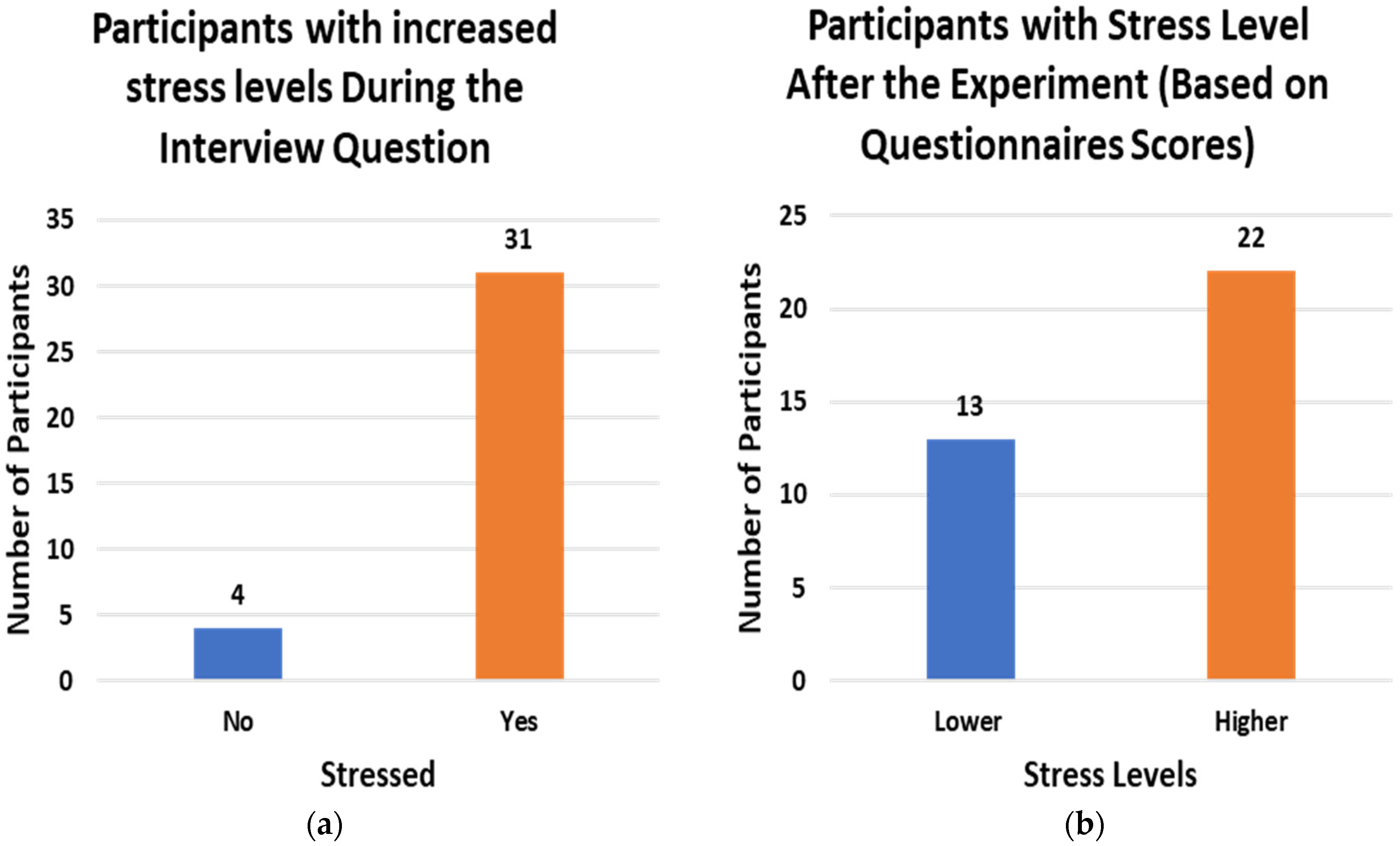
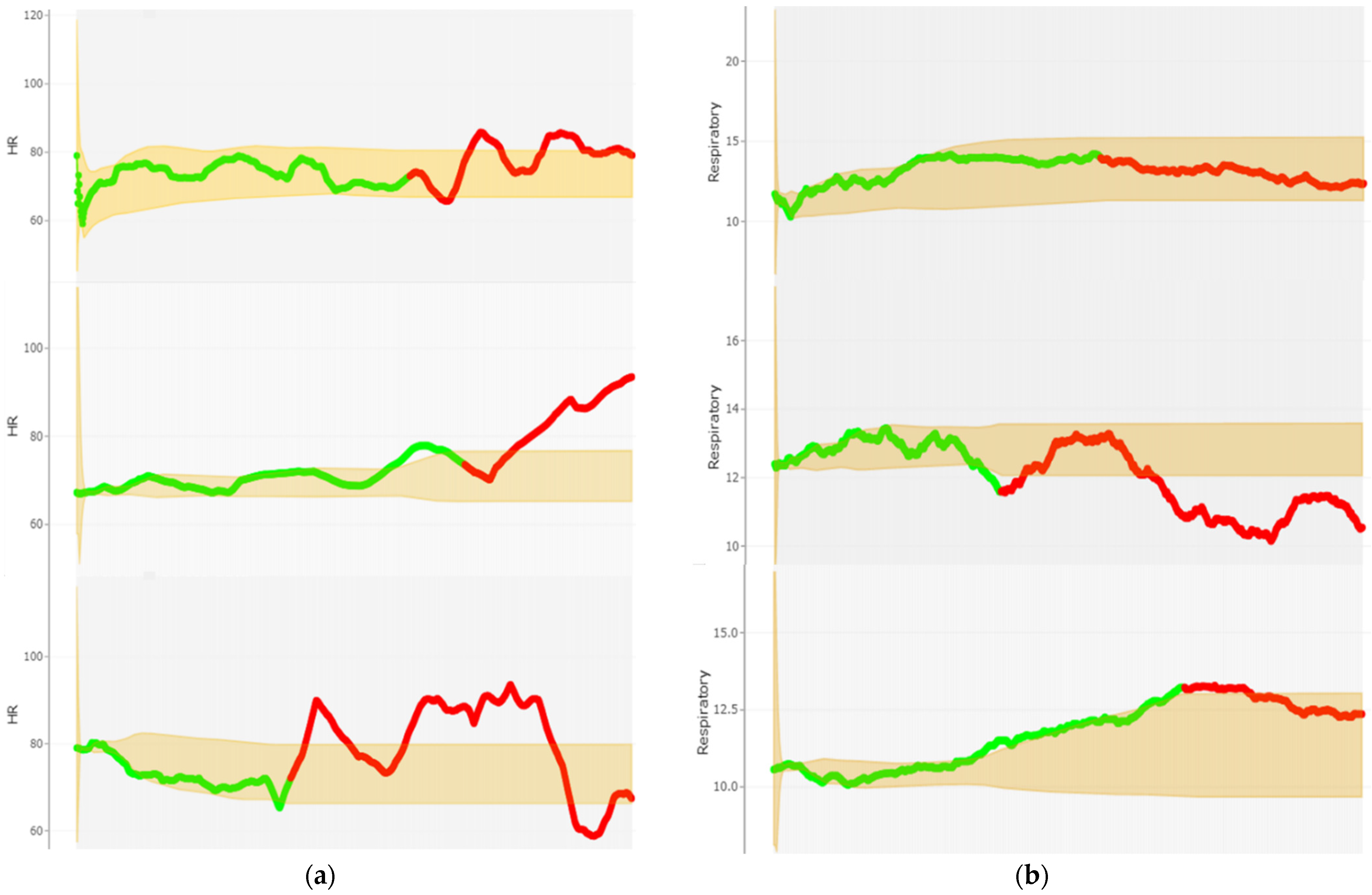
| Inclusion Criteria | Exclusion Criteria |
|---|---|
| Healthy (no underlying health condition) | No consent |
| Age between 18 and 75 years | Unhealthy |
| English speaking (all ethnicities) | Breastfeeding mothers, pregnant women |
| Give consent | Colour-blind |
| UNIX Start t | IBI |
|---|---|
| t0 | d0 |
| t1 | d1 |
| t2 | d2 |
| Features | Samples |
|---|---|
| Blood Volume Pulse (BVP) | 212,234 |
| Heart Rate (beats per min) | 3308 |
| Respiratory Rate (breaths per min) [Calculated using sliding window of 10 s] | 3308 |
| Predictors | Estimates | Confidence Intervals | p-Value | |
|---|---|---|---|---|
| Lower | Higher | |||
| (Intercept) | 80.36 | 76.85 | 83.88 | <0.001 |
| Time | −2.65 | −5.85 | 0.55 | 0.105 |
| Group [Stress] | 1.40 | 1.10 | 1.71 | <0.001 |
| Time * Group [Stress] | 5.05 | 4.36 | 5.74 | <0.001 |
| Observations | 112,472 | |||
| Predictors | Estimates | Confidence Intervals | p-Value | |
|---|---|---|---|---|
| Lower | Higher | |||
| (Intercept) | 12.68 | 11.98 | 13.39 | <0.001 |
| Time | −0.30 | −1.02 | 0.41 | 0.408 |
| Group [Stress] | 0.20 | 0.16 | 0.24 | <0.001 |
| Time * Group [Stress] | −1.11 | −1.19 | −1.03 | <0.001 |
| Observations | 112,472 | |||
| Heart Rate | Respiratory Rate | Heart Rate |
|---|---|---|
| Test | Stress (Outside Baseline Values) | Stress (Outside Baseline Values) |
| Stroop Test | 24/34 | 19/34 |
| Trier Social Stress Test | 28/34 | 27/34 |
| Hyperventilation Provocation Test | 18/34 | 16/34 |
| Study | Devices Used | No. of Subjects | Methods | Features | Limitations | Pros |
|---|---|---|---|---|---|---|
| [16] | RespiBAN and Empatica E4 | 15 | BVP, EDA, EMG and Temperature sensors | Heart rate, skin conductance, respiratory rate, muscle activation and skin temperature | Uses chest band Subjects must remain immobile Not a translational (practical) model (use of chest band) No justification of selected sample size | Data gather through chest band is highly accurate Respiratory rate data obtained by chest band |
| [17] | Video camera, computer logging and Kinect device | 25 | Task load, mental effort, emotion, and perceived stress questionnaires | Facial expression, computer logging and 3D body posture monitoring | Need control environment Not a translational (practical) model (3D Kinect) No justification of selected sample size | Provided subjective (personalized) results (stress versus work condition) |
| [18] | Zephyr bio harness and Empatica E4 | 10 | EDA, temperature, BVP, camera | Skin conductance and temperature, heart rate, respiratory rate, and hand movements | Not a translational (practical) model (use of chest band) No justification of selected sample size | Data gathered through chest band are highly accurate Respiratory rate data obtained by chest band |
| [21] | Smart-phone and Wahoo chest belt | 35 | Number of calls, sleep length, distance, audio length, heart rate variation | Inter-beat-inter/heart rate | Not a translational (practical) model (use of chest belt) No justification of selected sample size | Big data (4 month) |
| This Work | Empatica E4 | 35 | BVP (wrist band) | Heart rate and respiratory rate | Limited (approx. 60 min) data Small subject age window | A translational (practical) model Justification of selected sample size Only Empatica E4 dataset with respiratory rate data Provides subjective outcomes |
Publisher’s Note: MDPI stays neutral with regard to jurisdictional claims in published maps and institutional affiliations. |
© 2022 by the authors. Licensee MDPI, Basel, Switzerland. This article is an open access article distributed under the terms and conditions of the Creative Commons Attribution (CC BY) license (https://creativecommons.org/licenses/by/4.0/).
Share and Cite
Iqbal, T.; Simpkin, A.J.; Roshan, D.; Glynn, N.; Killilea, J.; Walsh, J.; Molloy, G.; Ganly, S.; Ryman, H.; Coen, E.; et al. Stress Monitoring Using Wearable Sensors: A Pilot Study and Stress-Predict Dataset. Sensors 2022, 22, 8135. https://doi.org/10.3390/s22218135
Iqbal T, Simpkin AJ, Roshan D, Glynn N, Killilea J, Walsh J, Molloy G, Ganly S, Ryman H, Coen E, et al. Stress Monitoring Using Wearable Sensors: A Pilot Study and Stress-Predict Dataset. Sensors. 2022; 22(21):8135. https://doi.org/10.3390/s22218135
Chicago/Turabian StyleIqbal, Talha, Andrew J. Simpkin, Davood Roshan, Nicola Glynn, John Killilea, Jane Walsh, Gerard Molloy, Sandra Ganly, Hannah Ryman, Eileen Coen, and et al. 2022. "Stress Monitoring Using Wearable Sensors: A Pilot Study and Stress-Predict Dataset" Sensors 22, no. 21: 8135. https://doi.org/10.3390/s22218135
APA StyleIqbal, T., Simpkin, A. J., Roshan, D., Glynn, N., Killilea, J., Walsh, J., Molloy, G., Ganly, S., Ryman, H., Coen, E., Elahi, A., Wijns, W., & Shahzad, A. (2022). Stress Monitoring Using Wearable Sensors: A Pilot Study and Stress-Predict Dataset. Sensors, 22(21), 8135. https://doi.org/10.3390/s22218135






